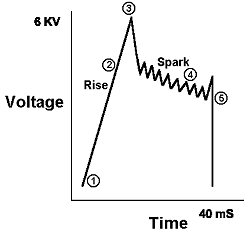 When the ignition system, through a series of signals, finally sends voltage (1) to the spark plug, that energy does not arrive at the plug instantaneously. It builds (2) until it reaches the level needed to "ionize" the plug's gap—that is, make the air within the gap electrically conductive (3). Once the gap is bridged, the voltage necessary to continue current flow is less than that required to initially get across the gap, so the voltage drops to the minimum necessary to keep flowing across. The energy dissipates as it flows (4), until it has dropped so low that it can no longer bridge the gap, at which point the spark stops. With the load removed from the coil, the voltage surges upward momentarily, as if trying to re-ionize the gap. But, lacking the voltage to do so, it is quickly spent and falls to zero (5).
When the ignition system, through a series of signals, finally sends voltage (1) to the spark plug, that energy does not arrive at the plug instantaneously. It builds (2) until it reaches the level needed to "ionize" the plug's gap—that is, make the air within the gap electrically conductive (3). Once the gap is bridged, the voltage necessary to continue current flow is less than that required to initially get across the gap, so the voltage drops to the minimum necessary to keep flowing across. The energy dissipates as it flows (4), until it has dropped so low that it can no longer bridge the gap, at which point the spark stops. With the load removed from the coil, the voltage surges upward momentarily, as if trying to re-ionize the gap. But, lacking the voltage to do so, it is quickly spent and falls to zero (5).
The voltage required to jump the spark plug gap is dependent mainly on the gap's size and the amount that the air is compressed in the cylinder. Larger gaps or higher compression raise the voltage required to jump the gap. The required voltage also changes with conditions. Typically 4 KV at idle, it may climb to 6 KV or more at high rpm and 10-12 KV during acceleration. But it is never as much as the system rating. A system's rating is what it is in order to support a specific spark plug gap, provide the reserve voltage necessary for extreme conditions and wear, and provide the electrical "push" which ensures the spark plug's rapid voltage rise.
How quickly the spark plug voltage rises is very important. It is so important that it is one of the key areas in which all the different types of ignitions may be most logically compared.